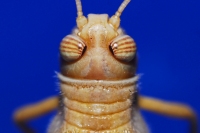Insects Deceived by the ‘Razzle Dazzle’

Photograph taken by IBERS postgraduate student Lisa Clancy
04 December 2013
‘Dazzle camouflage’ (or ‘razzle dazzle’) was a tactic devised by British marine artist Norman Wilkinson during World War One to prevent German U-boats sinking so many British ships. In 1917 he decorated ships in conspicuous geometric patterns which were intended not to hide the vessel, but to confuse the eye of the onlooker so that it was more difficult for them to judge its speed and trajectory.
Dazzle camouflage may have been inspired by nature, since the high-contrast stripes of zebras and some snakes have been proposed to achieve the same effect. However, whether on snakes or ships, evidence that dazzle patterns really disrupt motion perception in observers has been patchy.
Dr Santer, a member of IBERS’ Aquatic, Behavioural and Evolutionary Biology Research Group (ABEB), explains that “while studies on humans have provided tantalising glimpses into the dazzle camouflage effect, there is limited consensus in results across studies. This study is the first to demonstrate the effect in a prey animal, and on a mechanistic level”.
Dr Santer’s study used locusts, which are equipped with specialized visual neurons that respond to the approaches of looming, predator-like objects and trigger the locust’s escape from them. The activity of these neurons was monitored using electrodes, whilst locusts watched a screen on which animated squares with varying patterns would periodically loom at them.
An earlier investigation had found that bright and dark visual stimuli had antagonistic effects on the responses of the locust’s predator-detecting neurons. Dr Santer’s study demonstrates that, as a result of this effect, squares with bright and dark patterns caused the locust’s visual neurons to respond more weakly, and later, during an approach… meaning that the lunge of an attacker with high-contrast markings would actually be more difficult for a locust to detect and evade than that of a more plainly patterned predator.
Dr Santer believes that insects are excellent subjects for investigating dazzle camouflage. “The great thing about insects is that they are so easy to study in the lab”, he explains, “two of our undergraduate zoology students are researching dazzle camouflage in my lab right now, so it’s fantastic that they can study such an exciting topic”.
And Dr Santer believes that there’s plenty more to do. “The next step is to find out whether predators have evolved markings that exploit the dazzle effect”, he says.
Dr Santers' research paper 'Motion dazzle: a locust's eye view', has been published in the Biology LettersJournal (Santer RD (2013). Biology Letters: 9 (6): 20130811).



